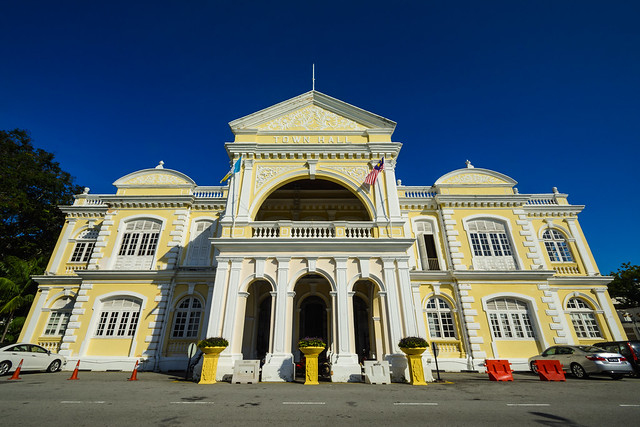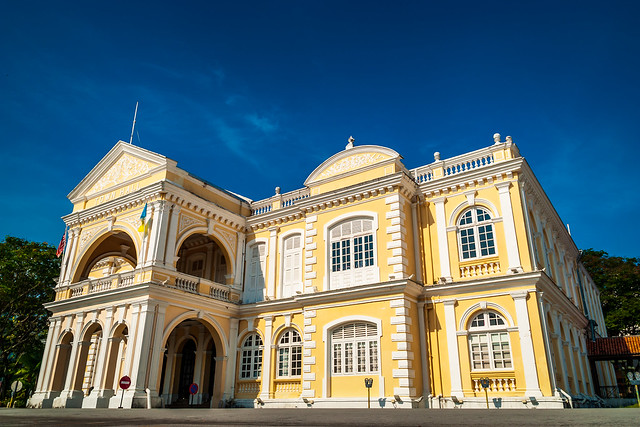 |
The Town Hall in 2015 - the front portico with its triangle and semi-cricle pediment
|
Since Francis Light took possession of Penang Island in 1786, the development in Penang recorded slow progress especially after the British occupied Singapore in 1819. Penang lost its popularity to Singapore as the British trading port due to Singapore's location which was more strategic besides its being declared as a free port by Stamford Raffles in 1819. It was recorded that by 1825, the population of Singapore had passed the ten thousand mark, with a trade volume of $22 million. By comparison, the trade volume for the long-established port of Penang was $8.5 million during the same year.
In fact, according to Wendy Khadijah Moore in Malaysia - A pictorial history 1400 - 2004, for most of its first 50 years, Penang was a financial burden to the English East Indian Company. but official lifestyles were nevertheless luxurious. European administrators built their spacious mansions along North Beach, on the seaward side of Light Street, setting a trend that was quickly followed and outpaced by successful locals.
Penang's public facilities were greatly improved in the late 1830's and Penang's fortunes soared when the port became the main outlet for the produce of the northern Malay states in the 1870s due to tin boom and later a meteoric rise in rubber industry. Inspired by Singapore, George Town constructed modern front along Beach Street and the newly reclaimed Weld Quay and implemented new standards of architecture for public buildings, banks and shipping offices.
PUBLIC HALL FOR ENTERTAINMENT AMONG THE COLONIAL ELITES
 |
The earliest version of the Town Hall, c1880s. (Image was reproduced from Malaysa - A pictorial history 1400-2004, used without permission but in accordance with the principle of fair use)
|
The Town Hall is the oldest Municipal Building in Penang and among the earliest public buildings in Penang that still survives. Located at Lot No. 70, Section 19, George Town, North-East District, Penang Island, the building occupies a land area of 70,711 square feet along Jalan Padang Kota Lama (formerly Esplanade Road), facing the famous Esplanade. (The Esplanade takes its name from military terminology in which an Esplanade is an expanse of land between a fortification and other buildings. Its purpose was to enable an unobstructed view of the fort’s surroundings; an open piece of no-man’s land which an enemy would have to cross under fire from the fort).
The land on which the Town Hall now stands was once occupied by a private residence owned by merchant George Seton. It was leased as a house for visiting admirals of the British navy until it was destroyed in a massive town fire in 1812.
The Town Hall was said to have been designed by military engineers Captains Innes and Satterthwaite. Its primary function was to provide a public hall for entertainment, the lack of which had been complained about for many years prior. Tenders to construct this building were called for in July 1878 and the foundation stone was laid on 1 January 1879 by Lieutenant Governor, Colonel Archibald Anson.
The historic building was designed and built in the British Palladian architectural style during Victorian-era. It featured classical arches, columns, pilasters, quoins, ornamental elements on roof parapet and balustrades. This symmetrical, two-storey building consists of a front portico, an assembly hall, a ballroom with adjoining supper rooms, a performance stage, office rooms and a library.
It cost around Sp$35,000 and was opened on 6 August 1880 by the Straits Settlements Governor, Sir Frederick Weld, with a public ball. This was before the days of electricity and the entrance and ballroom were lit by ‘hundreds if not thousands of coconut oil lamps’ which had been supplied by Katz Brothers. Some of the first electric lighting in Penang was temporarily installed in the Town Hall during a ball in 1883, but kerosene lamps were kept lit as well in case of power supply problems.
Initially The Town Hall housed the Municipal offices where Council meetings and elections were held regularly. In 1903, the Municipal offices were moved to the newly built City Hall in view of an increase in taxes and assessments collections, resulting from the rapid expansion of George Town as a port city.
The Town Hall was primarily used as a social venue for the town’s European community, also known as the "Ang
Mor Kong Kuan" among the local Chinese which means the European Club. A town band comprising Filipino musicians performed at the Town Hall from 1890 to 1954. The building became a premier place for George Town’s social events, balls, public speeches, dramatic performances, art exhibitions and amateur concerts. Apart from administrative and social functions, the Town Hall housed the Penang Library for more than 20 years and a private college (Kolej Damansara Utama) for 8 years. Due to its immense historical and architectural values, the building was gazetted on 29th July 1982 under the Antiquities Act 1976 which was later replaced with the National Heritage Act 2005.
 |
The Town Hall featuring classical arches, pilasters, semi-circle windows, quoins and balustrade
|
This building of 30,552.23 square feet was built with brick, plaster walls, timber floorboards and ceiling at the upper floor, decorative ironworks at main entrance, cast iron roof at the back entrance and intricate designs of plaster renderings at cornices, mouldings and front parapet wall. Old photographs have shown that the building had had Chinese clay roof tiles before they were replaced with asbestos sheets. In 1890, the entrance hall was enlarged and four more rooms were added. The Old Town Hall was later renovated with its side wing extended and a covered balcony added over the front portico to provide a better view overlooking the sport and recreational activities in the grounds (The Esplanade).
The Town Hall has a balcony that overlooks the Esplanade. In the olden days, the elite used to gather on the balconies of the Municipal Council buildings to view the processions and games held below.
Through the years, the Town Hall has undergone five extensive expansions in 1890, 1903, 1938, 1958 and 1991 to accommodate the increasing demand for internal space and now comprises a front portico, an assembly hall, a ballroom with adjoining supper rooms, a stage, office rooms and a library. During the filming of the 20th Century Fox movie “Anna and the King” in Penang in 1999, the Town Hall’s ballroom on the first floor was transformed into the Royal Hall of Justice where three judges presided over Princess Tup Tim’s trial.
 |
Town Hall fronts on to Esplanade Road (now Jalan Padang Kota Lama) captured in 2015
|
Free Malaysia Today News reported on 2 July this year that the Penang State Government had announced the Penang's iconic 140-year-old heritage building would undergo major restoration at a cost of RM8 million as the building had now fallen into disuse.
In announcing the repairs, the state Local Government Committee chairman Jagdeep Singh Deo said the repairs will strictly follow the Unesco World Heritage Site guidelines.
 |
The Town Hall's front facade and its two-storey portico topped with the triangle pediment photographed in 2012.
|
 |
Jalan Padang Kota Lama (formerly Esplanade Road)
|
REFERENCES
A. Ghaffar Ahmad. (2004). Scientific studies and laboratory tests in the restoration of Old Town Hall, Georgetown, Penang. Retrieved from http://www.hbp.usm.my/conservation/SeminarPaper/TownHall.htm
Chen, V.F. (2007). The encyclopedia of Malaysia - Architecture. Kuala Lumpur: Editions Didier Millet.
Historic building. (n.d.) George Town World Heritage Incorporated. Retrieved from http://gtwhi.com.my/historic-buildings/
Langdon, M. (2010). George Town’s historic commercial and civic precincts. Retrieved June 8, 2015 from http://gtwhi.com.my/images/pdfs/George%20Towns%20Historic%20Commercial%20and%20Civic%20Precincts.pdf
Moore, W.K. (2004). Malaysia - A pictorial history 1400-2004. Kuala Lumpur: Editions Didier Millet.
Predeep Nambiar. (2020, July 2). Penang’s iconic town hall to undergo RM8 mil facelift. Free Malaysia Today. Retrieved from https://www.freemalaysiatoday.com/category/nation/2020/07/02/penangs-iconic-town-hall-to-undergo-rm8-mil-facelift/
Tan, L.K., & Lim, Y.M. (n.d.).
Cost Centres for Restoration Work: A Case Study ofTown Hall in George Town, Penang. Retrieved from https://www.irbnet.de/daten/iconda/CIB18890.pdf






Comments
Post a Comment